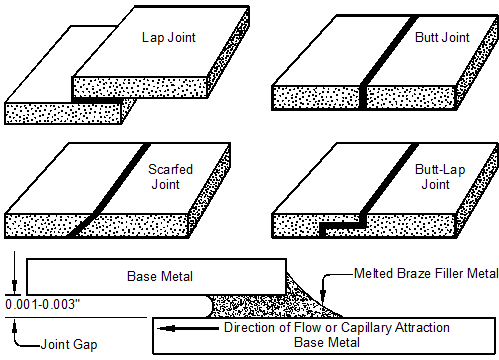- Preface
- Acknowledgements
- Chapter 1: Welding Overview
- Chapter 2: Safety
- Chapter 3: Terms, Joints, & Edge Preparation
- Chapter 4: Tools & Welding Tables
- Chapter 5: Shielded Metal Arc Welding
- Chapter 6: Wire Feed Welding
- Chapter 7: Gas Tungsten Arc Welding
- Chapter 8: Oxyacetylene
- Chapter 9: Controlling Distortion
- Chapter 10: Cutting Processes
- Chapter 11: Brazing & Soldering
- Chapter 12: Common Problems & Solutions
- Chapter 13: Design Tips
- Chapter 14: Fabrication & Repair Tips
- Chapter 15: Tools & Tooling
- Chapter 16: Pipe & Tubing
- Chapter 17: Metallurgy
- Chapter 18: Power Supplies & Electrical Safety
- Chapter 19: Bending & Straightening
- Index
- Credits
Chapter 11
Brazing & Soldering
There is nothing more useless as doing efficiently that which should not be done at all.
—Peter F. Drucker
Section I – Brazing Basics
Brazing Basics
Brazing joins metals with the addition of braze filler metal, also called brazing alloy, which melts at temperatures above 840°F. Often two different metals are joined by brazing.
Here are the steps to braze a joint:
- Be sure that the joint surfaces are designed or modified for good fit with clearances of 0.001–0.003 inches. This provides the best capillary attraction to draw filler metal into the joint to assure maximum joint strength.
- Surfaces to be brazed must be cleaned of oil, paint, rust and dirt. Often an alcohol or acetone wipe-down is used to remove remaining oils.
- Flux is usually added to chemically clean—and sometimes etch—the joint surfaces to prepare them for the braze filler metal. Additionally, by creating a protective atmosphere, flux prevents both the filler and work metals from oxidizing during the heating process.
- The parts are positioned for joining and can be held in a fixture. Two flat parts can be merely placed one on top of the other.
- The joint is heated slightly above the melting point of the filler metal. The melting temperature of the filler metal is lower—sometimes substantially lower—than the melting point of the workpiece metal. Capillary attraction draws the melted filler metal into the joint. Inside the joint, the filler metal wets the base metal forming intermetallic compounds or alloys between the base and filler metals at their interface. See Figure 11-1.
- When the filler metal cools and solidifies, the joint is complete. Atomic attractive forces hold the joint together at the braze metal and base metal interfaces. This is called adhesion.
- The joint is then cleaned to remove flux, which is corrosive and could weaken the joint and affect its appearance.
Wetting & Capillary Attraction
Wetting action between the filler and base metals is facilitated by the ability of the filler metal to alloy with the base metal at their interface. For example, pure lead does not readily wet copper or steel or adhere to either metal, but a tin-lead alloy readily wets both copper and steel. This preference of filler metal for atoms other than its own causes the wetting action of the base metal. Although wetting is often called tinning, this term is misleading because wetting action occurs between many different metals, not just tin. If filler metal does not wet the base metal, and instead balls up to form small spheres, this is usually caused by a dirty base metal surface or the lack of a proper flux.

In summary, capillary forces draw the filler metal into the joint and when the filler metal cools and solidifies, interatomic forces hold the joint together.
Joint strength is greatly affected by the condition of the brazed surfaces. In addition to surface cleanliness, surface roughness influences brazed joint strength. A rough surface provides more surface area for the filler metal to bond to, forming a stronger joint. Also, a roughened surface often has a jagged contour that traps and locks the filler metal in place, further strengthening the joint mechanically. Brazed joint strength results from both atomic and mechanical forces. To achieve the required strength, the joint surfaces may be roughened mechanically or chemically.
Soldering vs. Brazing
The distinction between brazing and soldering is the temperature at which these processes are performed. Brazing takes place above 840°F and soldering below 840°F, but otherwise the two processes are quite similar. Brazed joints are considerably stronger than soldered joints because the strength of brazing filler metals is greater than the strength of solders. However, the joint strength of brazed joints on non-ferrous metals and steels can be greater than the tensile strength of the filler metal itself because of the thinness of the joint and the interatomic adhesion forces at work. On stainless steels, joints with tensile strength greater than 130,000 psi are possible. Brazing often achieves nearly the strength of a welded joint without the problems of heat distortion and, because the seam line is thin, the joint can be concealed.
Brazing vs. Braze Welding
Brazing uses capillary attraction to draw filler metal into the mating joint, while in braze welding the filler metal is deposited in grooves or fillets at the points where needed for joint strength. With braze welding capillary attraction is not a factor in distributing the filler metal since the joints are open and exposed to the welder. Wetting of the base metal by the filler metal results in atomic bonds which are the same for brazing, braze welding, and soldering.
Braze welding is not a brazing process, but a welding process that uses braze filler metal. Joint designs are similar to those for the oxyacetylene welding of V-groove butt joints, lap joints, T-joints, fillets and plug joints. Braze welding is an important and effective repair method for cracked or broken cast iron and aluminum parts, and many large machinery castings can be successfully repaired this way. For example, large areas of damaged aluminum outboard propeller blades can be built up or replaced using a low-temperature solder in a fashion similar to braze welding.
In one instance, a new hydraulic shear in a production department was misused by a maintenance man on a Saturday when no supervisor was present. The mechanic attempted to shear the maximum thickness for steel, but in stainless steel. The side of the shear casting snapped and was repaired with braze welding—a repair that lasted for more than 20 years.
As with brazing, braze welding does not melt the base metal and is performed at a lower temperature than welding, resulting in much less distortion of the work. Also, since braze welding is performed only on a small area of the part, the entire part does not need to be brought up to braze temperature at once. This is a big advantage when repairing large castings. See Section IX, Repairs Made with Braze Welding, page 315.
Metals Joined by Brazing & Soldering
Most common metals can be brazed including: aluminum, bronze, brass, cast iron, copper, stainless steel, carbon steel, titanium, some tool steels and tungsten carbide. Nearly all metals can be soldered. If two different workpiece metals can be wetted by the same filler metal, they can be brazed or soldered together.
Process Temperature Selection
Temperatures are selected so that the braze or solder metal is completely liquid, which allows it to readily flow into the joint and quickly wet the surfaces. This temperature, though, must be as low as possible so as not to affect the work metal, burn the flux, or burn the surrounding work. When using the correct flux and correct process temperature, both the capillary attraction and the wetting action occur in less than a second.
Brazing Advantages
- Low temperature process – The components being joined, such as semiconductors and other electronic components, are less likely to be damaged since the base metals do not reach their melting temperatures.
- Ability to join dissimilar metals – Steel is easily joined to copper, cast iron to stainless steel, and brass to aluminum.
- Able to join non-metals to metals – Ceramics and glass are easily joined to metals or to each other.
- Joins parts of widely different thicknesses – Either thin-to-thin or thin-to- thick parts may be joined without burn-through or overheating, which can be a serious problem when welding.
- Excellent stress distribution – Many of the distortion problems of fusion welding are eliminated because brazing has lower process temperatures, even heat distribution, and more gradual temperature changes.
- Economical for complex assemblies – Many parts can be joined in a single step. Often complex parts are more economically made by brazing several pieces together rather than machining the part from a single piece of metal. This method results in a savings of both raw material and machining time.
- Good for joining precision parts – Using proper jigs and fixtures, parts can be very accurately positioned.
- Parts can be temporarily joined – After being temporarily joined, parts can undergo other manufacturing processes and then be separated without damage.
- Parts can be assembled rapidly – Processes are readily adaptable to utilize batch brazing as well as automatic assembly operations.
- Mistakes are easily fixed – A misaligned part is simple to reposition.
- Ability to make leak-proof and vacuum-tight joints – Many tanks and vessels are soldered or brazed. High-power radio transmitter vacuum tubes and integrated circuits with metal to ceramic joints are also brazed.
- Joints require little or no finishing – With proper process design, brazed or soldered joints can be nearly invisible.
- Combined brazing and heat treatment cycles – When protective-atmosphere brazing is used, the brazing process may be incorporated into the heat-treatment cycle.
Brazing Disadvantages
- Brazing processes are rarely as strong as fusion-welded joints.
- The brazed parts and filler metal may have a poor color match.
Section II – Joint Design & Cleaning
Joint Design
Well designed braze and solder joints start with fundamental butt, lap and scarfed joints as shown in Figure 11-2 (top & center). Scarfed joints are stronger than if the same materials were butted together because scarfed joints provide more surface area to which the filler metal can adhere. The bottom of Figure 11-2 shows a detail of a brazed lap joint.

The maximum strength of a simple lap joint can be increased by an overlap of three times the thickness of the base metal (3T). This is sometimes called the Rule of Threes. More overlap without additional refinements will not improve joint strength, but tapers or smooth transitions in thickness, as shown in Figure 11-3 (left, bottom two joints), make stronger joints.

